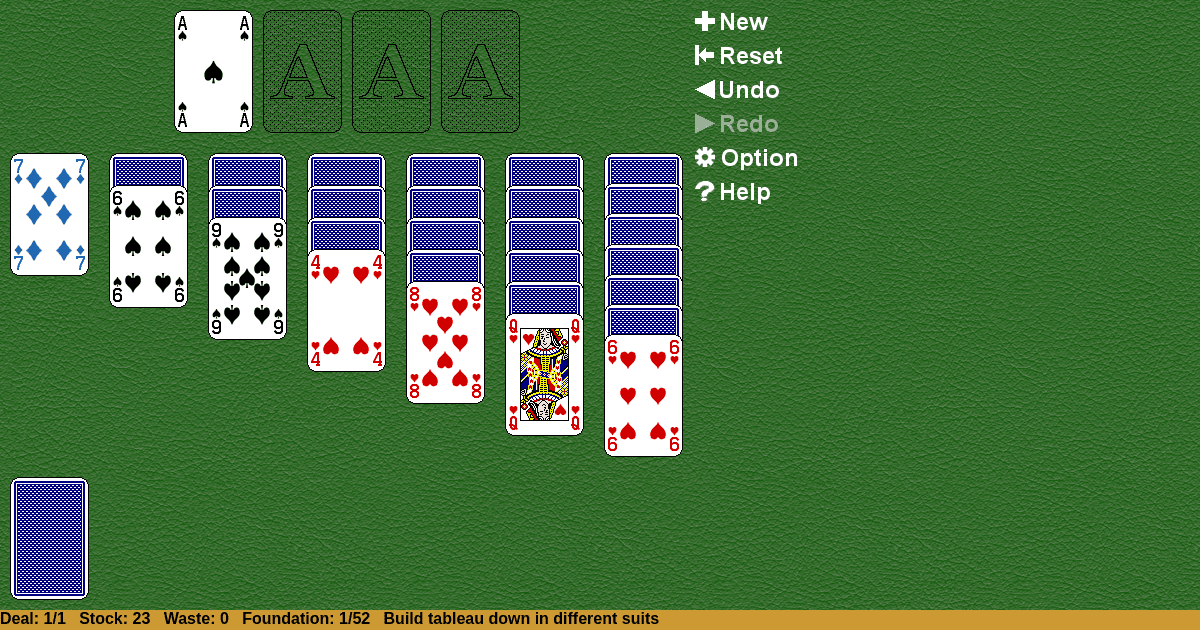Thumb and Pouch
Home |
How to play |
FAQ |
About
How to play Thumb and Pouch?
Game Objective:
The primary goal in Thumb and Pouch Solitaire is to move all cards from the tableau and stock to the four foundation piles, building each foundation up in suit from Ace to King.
Setup & Layout:
- Deck: Use a standard 52-card deck.
- Tableau: There are seven tableau piles. Deal cards left to right:
- 1st pile: 1 card (face up)
- 2nd pile: 2 cards (top card face up, the rest face down)
- Continue this pattern until the 7th pile, which has 7 cards (top card face up, the rest face down).
- Foundations: Four empty foundation piles above the tableau.
- Stock: The remaining undealt cards form the stock, kept face down.
- Waste: The waste pile is initially empty. Cards from the stock are dealt here, one at a time, face up.
Key Play Areas:
- Tableau: Main play area; seven columns where most gameplay occurs.
- Foundations: Target piles for building up each suit.
- Stock: Draw pile.
- Waste: Receives cards from the stock for potential play.
Thumb and Pouch Solitaire Rules:
Card Movement Principles:
Foundations:
Only Aces may be moved to empty foundations.
Foundations build up in suit (e.g., Ace♠, 2♠, 3♠, …, King♠).
Only the top card of a foundation pile is available for play.
Tableau:
Build down by rank, but not by the same suit (e.g., any 6 except 6♠ can be placed on 7♠).
You may move any single card or a contiguous sequence of cards (a "build"), regardless of suit or color, as a group.
Any card or valid build can be moved to an empty tableau pile.
The top card of each tableau pile is always face up and available for play.
Stock and Waste:
Deal one card at a time from the stock to the waste.
Only one pass through the stock is allowed (no redeals).
The top card of the waste pile is available for play to the tableau or foundations.
Gameplay:
- Move cards within the tableau: Build down by rank, avoiding the same suit. Move single cards or valid sequences as allowed.
- Move cards to foundations: Whenever possible, move cards to the foundation piles, building up in suit from Ace to King.
- Fill empty tableau spaces: Any card or valid build may be moved into an empty tableau slot.
- Draw from stock: When no further moves are possible or desirable, deal one card from the stock to the waste pile.
- Play from waste: The top card of the waste pile can be played to the tableau or foundations if legal.
- Continue play: Alternate between moving cards within the tableau, to the foundations, and drawing from the stock until no more legal moves are possible or all cards are in the foundations.
Winning & Losing Conditions:
- Win: The game is won when all 52 cards are moved to the four foundation piles, each built up in suit from Ace to King.
- Loss/Unwinnable: The game is lost or unwinnable if no further legal moves are possible and cards remain outside the foundations, especially after the single pass through the stock is exhausted.
Special Rules & Edge Cases:
- Filling Empty Tableau Spaces: Any card or valid build (regardless of suit or color) may be placed in an empty tableau pile.
- Stock Limitation: Only one pass through the stock is allowed; there are no redeals.
- Build Movement: Unlike classic Klondike, you may move any group of cards (a build), regardless of suit or color, as a unit within the tableau.
- Tableau Build Restriction: Cards must be built down by rank, but never by the same suit (e.g., a 7♠ cannot be placed on a 6♠).
- Waste Pile: Only the top card of the waste is available for play; once cards are in the waste, they cannot be returned to the stock.
- No Partial Build Movement: Some sources clarify that only full builds or single cards may be moved, not partial builds from within a stack.
Definitions:
- Foundation: Target piles built up in suit from Ace to King.
- Tableau: Seven columns where cards are arranged and manipulated during play.
- Stock: The draw pile of undealt cards.
- Waste: Receives cards from the stock; only the top card is playable.
These rules distinguish Thumb and Pouch Solitaire from standard Klondike by permitting only a single pass through the stock and by allowing more flexible movement of builds within the tableau, provided the build-down restriction (not by the same suit) is followed.




























































